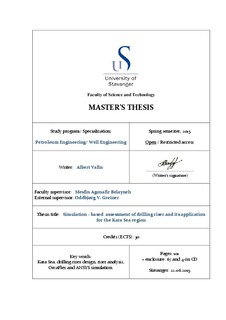| dc.description.abstract | Drilling in Arctic offshore conditions is a very challenging for the oil industry. With an increase in drilling operations in these harsh environments, drilling riser requirements and limits have become more critical due to uncertainties involved in response prediction.
Hence, during planning phase, a riser assessment should be performed with the objective of selecting the right riser in terms of size, material type and grade. The main purposes of the riser analysis are to define an operational window with regards to the environmental and applied loadings that a riser can tolerate without being failed.
This Master thesis is dedicated to the assessment and analysis of the drilling riser for the application in the Kara Sea region.
The riser is assessed in accordance with ISO 13624, API RP 16Q and DNV-OS-F201 standards, whose comparison and main features are also described in the thesis.
The analysis consists of two different design loadings - static and dynamic. The design environmental loads include the wind, sea currents, and waves which are combined with the drilling rig heave, pitch, roll motions for connected (drilling) and disconnected (non-drilling) design cases to ensure that the implemented riser design is capable to withstand the most severe loads and is reliable to be used for the drilling in the Kara Sea particularly.
The dynamic and static simulations of various riser configurations are carried out by means of OrcaFlex and ANSYS software respectively. During simulations in OrcaFlex, diverse loading scenarios are considered, varying the design wave height and their corresponding periods. The analysis is also conducted with regard to several different densities of the drilling fluid. Drilling risers are analyzed and compared based on API and ISO requirements for allowable limits of the Von-Mises stress, effective tension, and maximum upper and lower flex/ball joint angles.
After gaining an understanding of risers’ behavior in dynamic conditions, numerical modeling is established. A finite-element analysis in ANSYS 15.0 software is used to simulate and analyze two operational scenarios namely, normal and extreme (worst-case) conditions in the Kara Sea.
Based on the results of the analysis, this thesis work provides conclusions of the acquired findings, reasonable recommendations for the drilling riser design in arctic conditions of the Kara Sea and also indicate a potential future research areas. | nb_NO |
